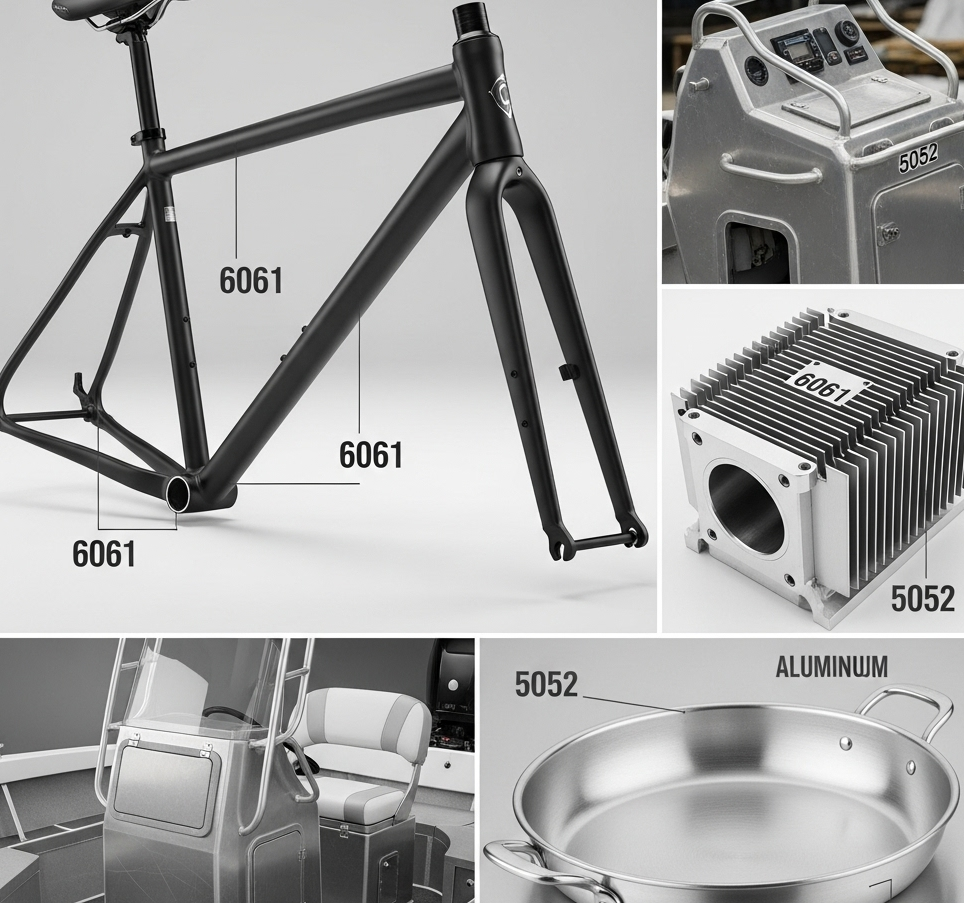Choosing the right aluminum for your CNC machining project can feel like a complex puzzle. You need a material that meets your specifications, but the wrong choice can lead to failed parts, budget overruns, and significant project delays.
The frustration of dealing with a material that corrodes unexpectedly or cracks during welding is a major setback. These issues compromise the quality of your final product and can damage your reputation, forcing you back to the drawing board and wasting valuable time and resources.
Understanding the key differences between 6061 aluminum and 5052 aluminum is crucial. This guide will help you select the ideal alloy for your specific application, ensuring optimal performance and manufacturing efficiency for your CNC milling projects.
When selecting an aluminum alloy for CNC machining, the choice between 6061 and 5052 is a frequent consideration. 6061 aluminum is a versatile, heat-treatable alloy known for its good strength-to-weight ratio and machinability. In contrast, 5052 aluminum is a non-heat-treatable alloy celebrated for its superior corrosion resistance, especially in saltwater environments, and excellent weldability. Your final decision will depend on the specific demands of your project, including required strength, environmental exposure, and post-machining processes like welding.
Navigating the technical specifications of materials like 6061 aluminum and 5052 aluminum can be challenging. However, understanding their core differences is essential for the success of any CNC machining endeavor. For this reason, we’ve broken down the comparison into key areas. Consequently, you can confidently make an informed decision that aligns with your project’s goals. Therefore, let’s explore the distinct properties that set these two popular aluminum alloys apart.

Material Properties: 6061 Aluminum vs. 5052 Aluminum
When delving into CNC machining, the material properties of your chosen alloy are paramount. Both 6061 aluminum and 5052 aluminum offer unique advantages. 6061 aluminum is an alloy containing magnesium and silicon, which allows it to be heat-treated to enhance its strength. This makes it a go-to choice for structural applications.
On the other hand, 5052 aluminum has magnesium as its primary alloying element. This composition gives 5052 aluminum its signature characteristics: excellent formability and resistance to corrosion. Unlike 6061 aluminum, it cannot be strengthened by heat treatment but can be strain-hardened. The selection process for your CNC milling parts hinges on these fundamental differences.
Corrosion Resistance Showdown
Corrosion resistance is a critical factor, especially for parts exposed to harsh environments. 5052 aluminum is the clear winner in this category. It exhibits outstanding resistance to corrosion, particularly in marine or saltwater conditions. This makes 5052 aluminum an excellent material for marine hardware, boat hulls, and chemical storage tanks.
While 6061 aluminum offers good corrosion resistance, it is more susceptible to attack in highly alkaline or saline environments. For many general-purpose applications, the corrosion resistance of 6061 aluminum is perfectly adequate. However, for projects demanding long-term durability against the elements, 5052 aluminum provides a more reliable solution for parts produced through CNC machining.

Weldability: A Key Consideration for Fabrication
Your project may require welding after CNC machining, and the choice between 6061 aluminum and 5052 aluminum significantly impacts this process. 5052 aluminum is known for its excellent weldability. It can be easily welded using common techniques, producing strong and ductile joints without a significant loss of its inherent corrosion resistance.
Welding 6061 aluminum, however, is more complex. The heat from welding can reduce the strength in the heat-affected zone by up to 80%. To regain some of this strength, a post-welding heat treatment is often necessary, adding complexity and cost to the manufacturing process. For applications requiring extensive welding, 5052 aluminum is often the more practical choice for CNC milling projects.
Strength, Hardness, and Machinability
Strength is often a deciding factor in material selection. Heat-treated 6061 aluminum, particularly the T6 temper, is significantly stronger and harder than any temper of 5052 aluminum. This makes 6061 aluminum ideal for structural components, automotive parts, and bicycle frames where a high strength-to-weight ratio is crucial.
In terms of machinability, both alloys perform well, but there are differences. 6061 aluminum is generally considered to have better machinability due to its hardness, which results in clean, well-formed chips during CNC milling operations. 5052 aluminum is softer, which can sometimes lead to “gummy” chips, though it is still readily machined. At ly-machining, our experienced machinists adjust speeds and feeds to optimize the CNC machining process for both 6061 aluminum and 5052 aluminum.

Here is a comparative table to summarize the key differences:
| Property | 6061 Aluminum | 5052 Aluminum |
| Primary Alloying Elements | Magnesium, Silicon | Magnesium, Chromium |
| Heat Treatable | Yes | No (Work-Hardened) |
| Corrosion Resistance | Good | Excellent |
| Weldability | Fair (requires post-treatment) | Excellent |
| Strength | Medium to High | Low to Medium |
| Machinability | Excellent | Good |
| Common Applications | Structural parts, electronics | Marine parts, sheet metal |
Price and Cost-Effectiveness
Cost is always a factor in manufacturing decisions. Typically, the raw material cost for 6061 aluminum and 5052 aluminum is quite similar, with prices fluctuating based on market conditions. However, the overall project cost can differ based on processing requirements.
For example, if your design requires extensive welding, choosing 5052 aluminum could be more cost-effective by eliminating the need for post-weld heat treatment. Conversely, if high strength is the primary driver and minimal welding is needed, 6061 aluminum might be the more economical choice. At ly-machining, we provide transparent quotes that consider both material and processing costs to help you budget effectively for your CNC machining needs.

Common Applications for 6061 and 5052 Aluminum
The distinct properties of 6061 aluminum and 5052 aluminum lead them to be used in different types of applications. Understanding these common uses can help guide your own material selection.
6061 aluminum is frequently used for:
- Structural components and framing
- Automotive and aerospace parts
- Bicycle frames and components
- Electronic enclosures and heat sinks
- CNC milling prototypes and fixtures
5052 aluminum is a popular choice for:
- Marine applications and boat hulls
- Sheet metal parts requiring significant forming
- Fuel and oil tanks
- Kitchen equipment and utensils
- Pressure vessels and chemical tanks
By considering these typical applications, you can better align your material choice with proven industry practices. Partnering with a knowledgeable CNC machining provider like ly-machining ensures you get expert advice tailored to your project.

Making the Right Choice with ly-machining
Ultimately, the choice between 6061 aluminum and 5052 aluminum depends entirely on the end-use of your part. If your project demands high strength and excellent machinability for a structural component, 6061 aluminum is an outstanding selection. If superior corrosion resistance, formability, and weldability are your top priorities, especially for parts exposed to the elements, then 5052 aluminum is the more suitable alloy.
At ly-machining, we specialize in CNC machining for both 6061 aluminum and 5052 aluminum. Our team can provide expert guidance on material selection, surface finishing, and quality control to ensure your project’s success. We are committed to delivering high-quality parts on time, backed by responsive after-sales support.
Related Questions
1. Can 6061 aluminum be used in marine environments?
While 6061 aluminum has good general corrosion resistance, it is not the preferred choice for marine or saltwater applications. The alloy can be prone to pitting corrosion in such environments over time. For superior performance and longevity in marine settings, 5052 aluminum is the highly recommended alternative due to its excellent resistance to saltwater corrosion. If 6061 must be used, it requires a protective coating like anodizing or paint.
2. Which alloy is better for bending and forming?
5052 aluminum is significantly better for bending and forming operations compared to 6061 aluminum. The lower strength and higher ductility of 5052 allow it to be bent to tight radii without cracking. In contrast, 6061 aluminum, especially in the T6 temper, is much more brittle and will likely fracture if subjected to aggressive forming unless it is annealed first.
Frequently Asked Questions
1. What is the main difference between 6061 and 5052 aluminum?
The primary difference lies in their alloying elements and properties. 6061 is a heat-treatable alloy with magnesium and silicon, offering high strength, while 5052 is a non-heat-treatable alloy with magnesium, providing excellent corrosion resistance and weldability.
2. Is 6061 or 5052 aluminum more expensive?
The raw material cost for 6061 and 5052 aluminum is generally comparable. However, the total project cost can vary. For instance, projects requiring significant welding may find 5052 more economical as it avoids the need for post-weld heat treatment that 6061 often requires.
3. Which aluminum is easier for CNC machining?
Both alloys machine well, but 6061 aluminum is often considered slightly easier to machine. Its hardness produces clean, manageable chips during CNC milling. 5052 aluminum is softer, which can sometimes result in gummy chips, but experienced shops like ly-machining easily adapt their processes to handle both materials effectively.

